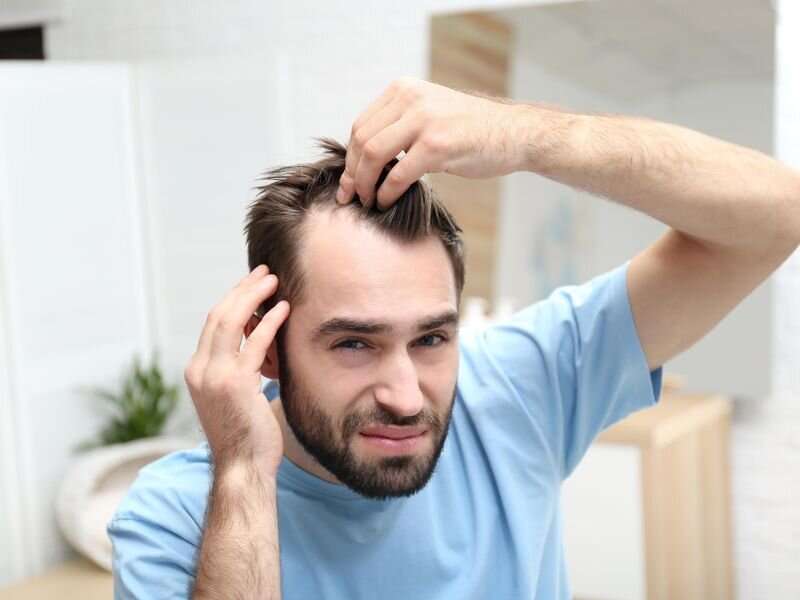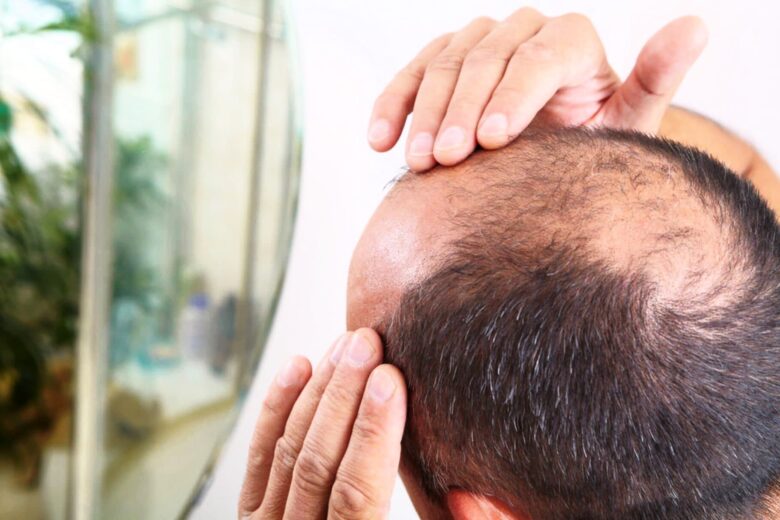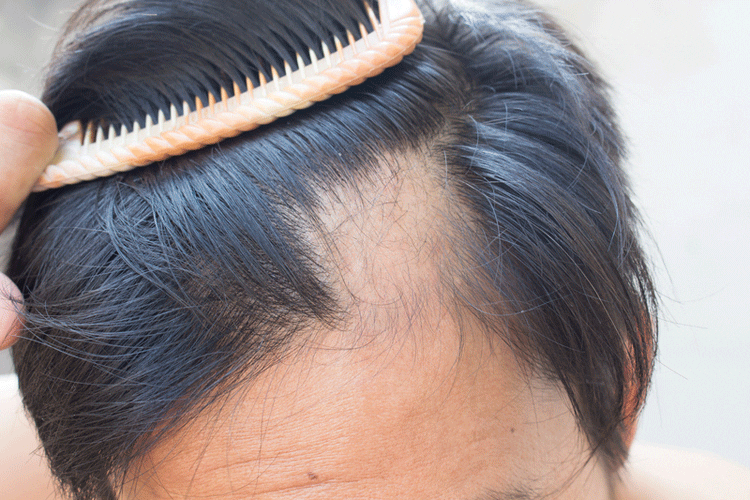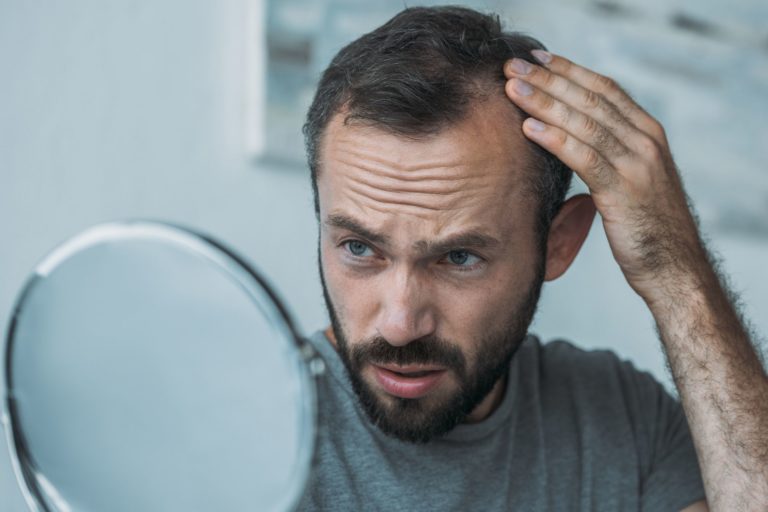A significant number of men worldwide are experiencing hair loss, commonly referred to as male pattern baldness or androgenetic alopecia. In this article, we will explore the causes, symptoms, and prevention strategies related to hair loss. We will delve into the intricate science behind it, the impact of lifestyle and genetics, and most importantly, how to manage and embrace this natural life change.
Contents
- What is Male Pattern Baldness?
- The Maestros Behind Male Pattern Baldness: Genetics and Androgens
- Surprising Contributors to Hair Loss in Men
- Harmonizing with Male Pattern Baldness: Styling and Treatments
- Emotional Impact of Male Pattern Baldness
- The Unfinished Symphony – Latest Scientific Breakthroughs in Hair Loss Treatment
What is Male Pattern Baldness?
Androgenetic alopecia is a universal maestro, conducting diverse melodies of hair loss across the gender spectrum. In the male symphony, it unveils itself as male pattern baldness, while in women, it harmonizes as female pattern hair loss, each showcasing its own unique composition.
For many men, middle age heralds a recital of receding hairlines, thinning hair, and burgeoning bald patches, a ballad that crescendos over time. In fact, over half of men over 50 have had front-row seats to this performance. However, the act may sometimes start as early as the late teens or early 20s.
While dealing with hair loss can feel like a heartbreaking solo, remember that it can be addressed with the right treatment or even transformed into a fashion statement with the right hairstyles. Read on to learn more about the causes, characteristics, and coping strategies for male pattern baldness.

Source: medicalxpress.com
The Maestros Behind Male Pattern Baldness: Genetics and Androgens
Most men will notice their hair growing thinner as they age, but male pattern baldness marches to the beat of a different drummer. It’s orchestrated by a mix of genetics and androgen sex hormones.
Genetics plays the first violin in this ensemble. A family history of patterned hair loss might set you up for a similar fate. While the exact melody genetics plays in causing male pattern baldness remains mysterious, studies have suggested that specific genes can shrink your follicles over time, eventually leaving you with bald patches.
On the other hand, androgen sex hormones, specifically dihydrotestosterone, serve as the percussion, driving the rhythm of male pattern baldness. Androgens don’t just help conduct male sexual development; they also influence hair growth in people of all genders. High levels of androgens can make your growth cycle hit a staccato, resulting in the growth of thinner, shorter strands of hair and a delay in new hair growth.
Surprising Contributors to Hair Loss in Men
Hair loss isn’t always a symphony of genetics and androgens. Sometimes, it’s a one-hit-wonder caused by certain medical conditions or stress, in which case the hair usually grows back. Conditions like alopecia areata, an autoimmune disease that attacks your follicles, or physical stressors like illness, surgery, or even emotional trauma can also play their parts in the hair loss opera.

Source: artistryclinic.co.uk
Harmonizing with Male Pattern Baldness: Styling and Treatments
Like a poorly tuned instrument, male pattern baldness often announces itself with a receding hairline or a bald spot at the crown of the head. As the hairline recedes and the hair grows thinner, the bald spot expands, creating distinctive patterns including:
- M-shape: The most prevalent form of receding hairline, the M-shape manifests as a triangular recession of hair at the temples, forming the distinctive “M” shape.
- V-shape: Comparatively less frequent than the M-shaped variant, the V-shaped hairline displays a receding hairline at the temples, giving rise to a recognizable “V” shape.
While male pattern baldness doesn’t require treatment, options exist for those who’d rather face the music head-on. Treatments can slow the tempo of hair loss or even help you regrow some hair. Many of these treatments are available over the counter or can be prescribed by a healthcare provider.
If treatments aren’t your style, a strategic haircut could help you rock your look.
- Buzz Cut: A closely cropped buzz cut can create an even and uniform appearance, minimizing the contrast between thinning areas and the remaining hair.
- Short Texture: Opting for a short textured hairstyle with layers can add volume and texture to the hair, diverting attention from areas of hair loss.
- Comb-Over: A classic comb-over involves styling the hair to one side, covering the thinning areas. This technique can be effective when done subtly and with the right hair products.
- Tapered Fade: A tapered fade cut features shorter sides and back with gradually increasing length towards the top. This style draws attention away from thinning areas and focuses on the well-styled top portion.
- Shaved Head: Embracing a completely shaved head can be a bold and confident choice, eliminating the concern about hair loss altogether.
It’s important to note that these styling options may not work for everyone, and it is always a good idea to consult with a professional hairstylist who can provide personalized advice based on your hair type, face shape, and pattern of hair loss.

Source: mydr.com.au
Emotional Impact of Male Pattern Baldness
Watching your hair thin out or fall can make you feel like you’ve missed a note. It can be hard to accept these changes, especially when it has played such a key part in your self-image. It’s important to remember, however, that you’re not alone on this stage. Male pattern baldness is a common experience for men around the world. Whether you decide to try hair loss treatment like prescription medication, hair transplants or a new hairstyle, do what makes you feel good about yourself and educate yourself on hair loss.
Here are a few tips for men to educate themselves on hair loss:
- Talk to your doctor. Your doctor can provide you with information about the causes and treatments for hair loss. They can also help you to rule out any underlying medical conditions that may be contributing to your hair loss.
- Do your research online. There are many websites, hair loss podcasts, and online forums that provide information about hair loss. You can also find articles and studies on the topic.
- Read books and magazines. There are many books and magazines written about hair loss. These can provide you with more in-depth information about the condition.
- Talk to other men who have experienced hair loss. They can share their experiences and offer advice.
The Unfinished Symphony – Latest Scientific Breakthroughs in Hair Loss Treatment
Imagine a world where male pattern baldness is a choice, not a destiny. Exciting strides in scientific research are painting a picture of that future. Let’s dive into some of the most promising recent advancements:
- JAK inhibitors: These wonder drugs have become the new hope in baldness therapy. Their unique ability to suppress JAK enzymes has proven effective in reviving sleeping hair follicles, at least in our furry friends, the mice. What a thrilling prospect if this translates to humans!
- Stem cell therapy: If you thought stem cells were impressive, you’re right! A ground-breaking study saw scientists successfully cultivating new follicles in mice through stem cell transplantation. We’re still awaiting the leap to human trials, but the future of using stem cells in combating male pattern baldness seems bright!
- MicroRNA magic: Among the smallest biological molecules, MicroRNAs, particularly miR-205, have emerged as key players in the hair loss process. Remarkably, enhancing miR-205 production appears to kick-start the growth process. It’s a microscopic change with a potentially huge impact!
Of course, scientific curiosity doesn’t stop there. Other mesmerizing research projects currently in progress include:
- Next-gen topical solutions: Numerous innovative lotions and potions are being developed to fight male pattern baldness. They aim to tackle the specific genes and proteins implicated in hair loss, creating a direct and targeted approach.
- Gene therapy: This futuristic solution to myriad diseases might be our trump card against male pattern baldness. The concept is fascinating: swap out the bad genes causing hair loss with healthy ones. If successful, this could halt or even reverse hair loss.
- 3D printing: Leveraging this rapidly evolving technology, scientists are exploring the potential of 3D-printed hair follicles. Imagine creating a personalized, effective, and natural-looking solution to male pattern baldness!
While a definitive cure for male pattern baldness remains elusive, the pace and direction of current research are incredibly promising.

Source: verywellhealth.com
Final Notes
Male pattern baldness is a common performance in the theatre of life. Influenced by genetics and male sex hormones, it’s characterized by thinning hair and a receding hairline that progresses over time. While the experience can be disheartening, treatments and certain hairstyles can help you face the music with confidence. Remember, you’re not alone in this concert, and there’s always a way to turn your personal symphony into a masterpiece.
